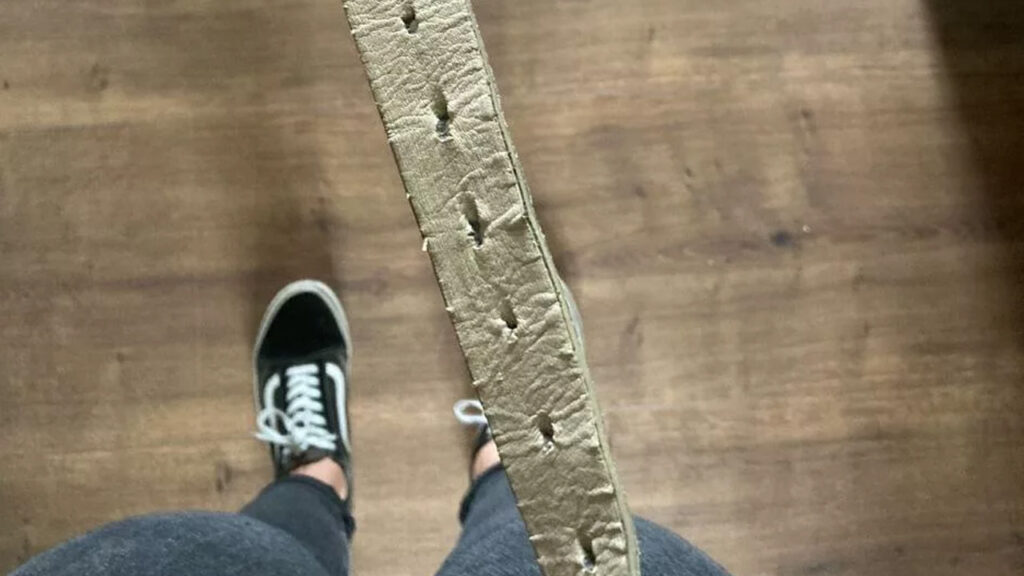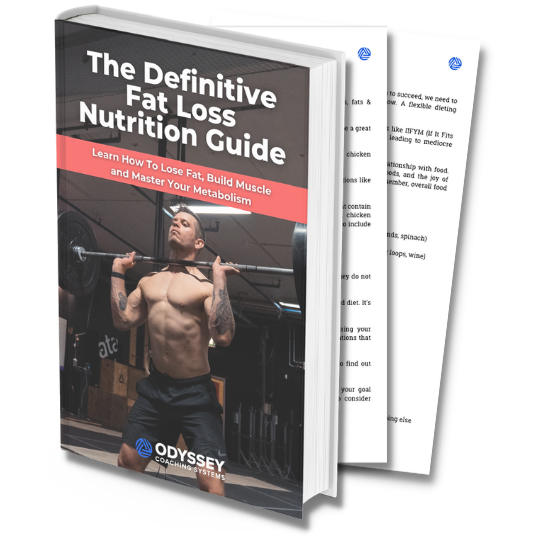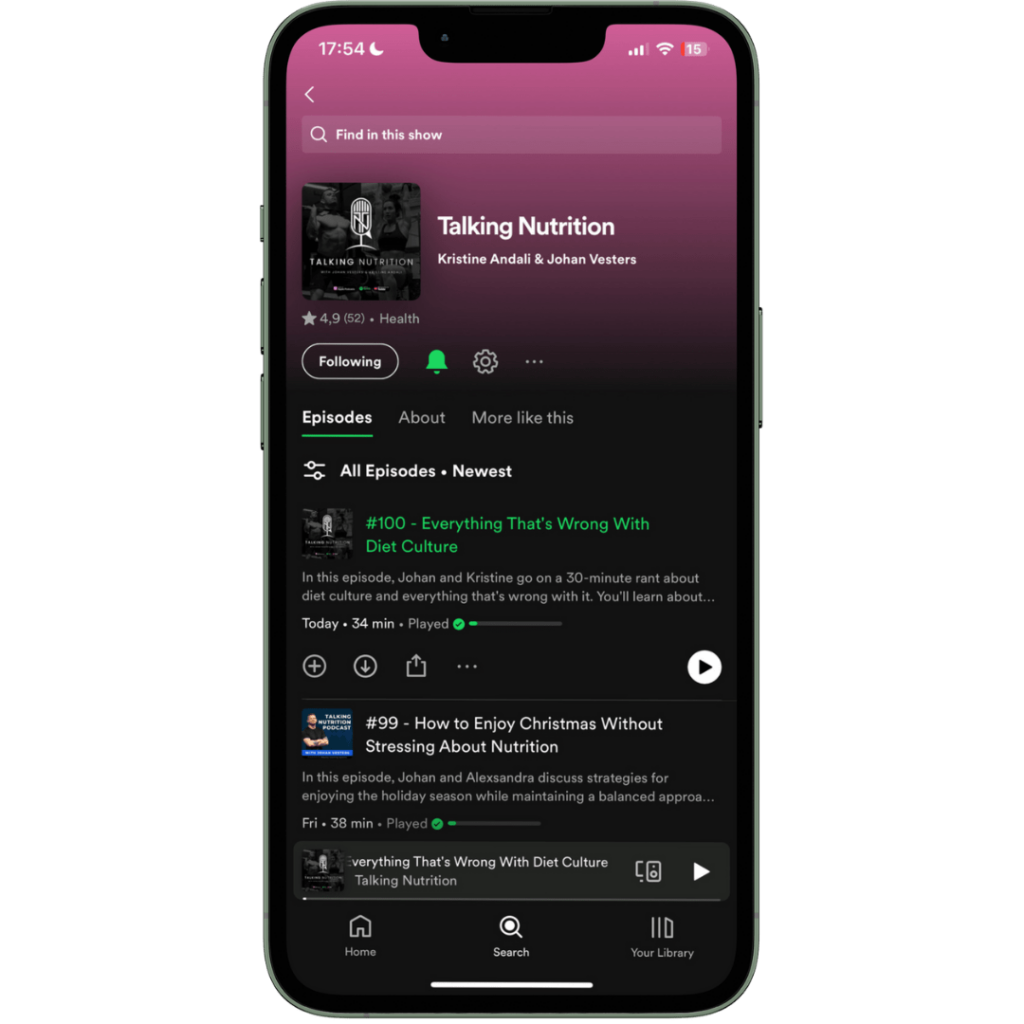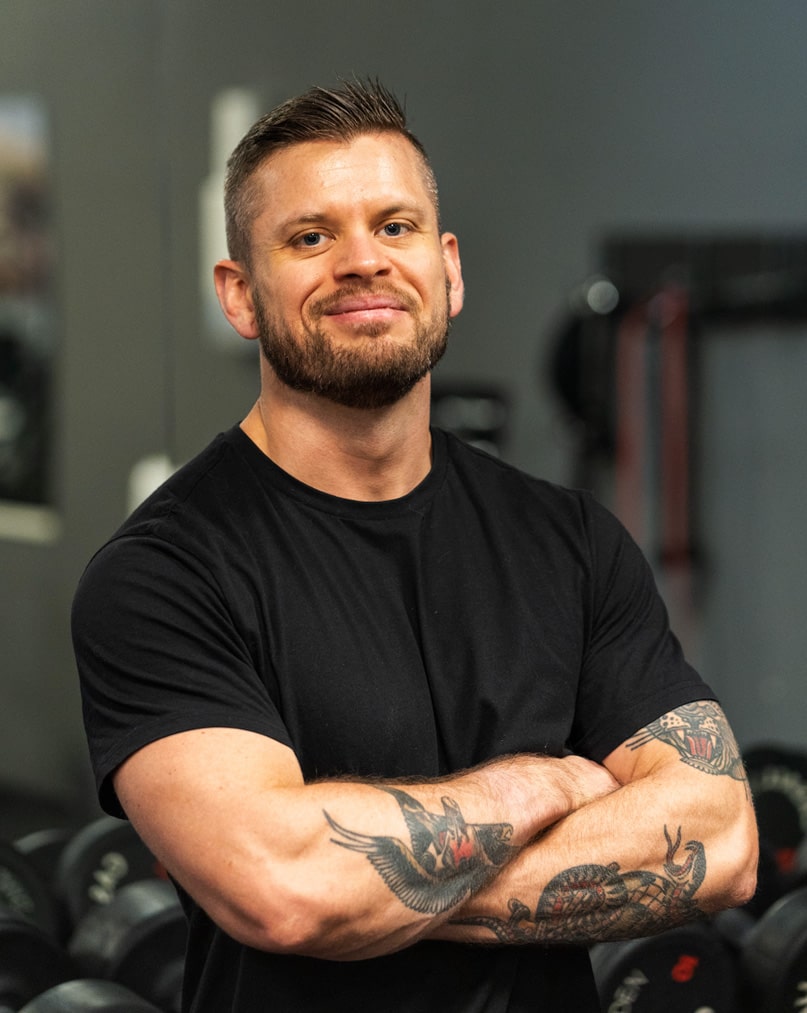Can you really lose weight by eating more, or is it total BS and should you just keep eating less and less while adding more and more cardio?
What’s a reverse diet? Why would you even consider eating more if your goal is to lose weight?
In this article we dive into my long time friend Femke’s transformation and how she went from under eating, struggling with low energy, having constant cravings, and not being able to lose weight, to dropping multiple clothing sizes, having a healthy relationship with food, and regaining her energy levels.
All by eating more..
Just eat less and move more
If I could wish for one thing to disappear forever, it’s this ‘just eat less and move more’ misconception around fat loss. Is there a time and place for more exercise and temporary food restriction? Yes, but you simply can’t keep lowering your food intake while ramping up the cardio more and more.
Femke had been trying to lose weight for years. She’d follow 1000kcal crash diets, and would often go from zero exercise to doing excessive amounts of cardio. Her energy levels were in the tank, she struggled with cravings, and she even blacked out a few times while running on the treadmill.
She’d lose weight, only to regain it again afterwards.
She worked together with her doctor, as well as a registered dietician. They told her “You just need to lose 10kg”, that she should avoid consuming fruits as well as fruit juices, because “You might as well drink Coca Cola then”. She had also heard that eggs were ‘as bad as cigarettes’. Big claims, which were neither true, nor useful.
After trying so many things, and not really getting the help she was looking for from professionals in the field, she’d just go back to eating less and moving more. She had no plan, there was no structure. The restrictive diets, combined with all that cardio weren’t sustainable, and cravings would often lead to binging over the weekends.
Time for a different approach
Especially once she got blood work done back in September 2020, which came back with less-than-favorable values, Femke knew things needed to change. She really wanted to find something more sustainable that would help her lose weight, but also keep it off. Something that would help her get in shape, that didn’t mean barely eating and passing out on the treadmill. Something that would actually improve her health…
Little did she know that a year later (September 2021) I’d be writing this very article here, to show you how she managed to finally lose the weight, and get her energy back, by eating more than she had done in years..
*Disclaimer: Please do not use any of the macronutrient or calorie amounts used in this article. Data is taken directly from Femke’s client file, and adjustments were made based on her check-ins, progress, biofeedback, and more. Macro and energy requirements need to be personalized to your individual body type, activity level, stress levels, history of exercise & dieting, etc..
Is it possible to lose weight by eating more?
Phase 1: Optimization
When Femke joined our online fat loss program, we didn’t just jump right into another diet. After years of failed diet attempts, another diet was the last thing she needed. Not to mention that after completing her food diary, we found out she was eating very little (1400kcal), with very small amounts of protein (56g). She just wasn’t ready yet, which wasn’t her fault. It was the health & fitness industry that had failed her.
So instead of cutting calories, we started off by putting her through what we call our ‘optimization phase’. Without getting too much into numbers in this article, her expected maintenance calories were somewhere around 2100-2200kcal. However, after eating so little for such a long time, her adapted maintenance was now around 1400kcal.
People will often blame their metabolism for their weight gain, they think it’s ‘broken’ or ‘damaged’ (terms that are also being thrown around by influencers these days). Truth is, your metabolism isn’t broken or damaged, it’s adaptive. Just how the thermostat in your living room will turn up or down the heat to regulate the temperature you set it to, your metabolism will up or down regulate your energy output to bring you back to what’s called ‘homeostasis’, a state of balance.
The metabolism doesn’t care about your physical goals, it just wants to keep you alive, to ultimately continue our species. It’ll keep you up and running, even during long periods of under eating. It’ll adapt based on your environment, stress, energy (food) availability, habits and overall lifestyle. So if anything, your metabolism would blame you, not the other way around.
The optimization phase can be a bit scary, especially after having tried so many diets in the past. I mean, would you want to eat more and more, while you maintain your weight or even gain a bit of weight – which is normal, and needs to be mentioned – if your goal is to lose weight?
Luckily, Femke came in armed with a positive mindset, she was excited, dedicated to the process, patient, and open for change.
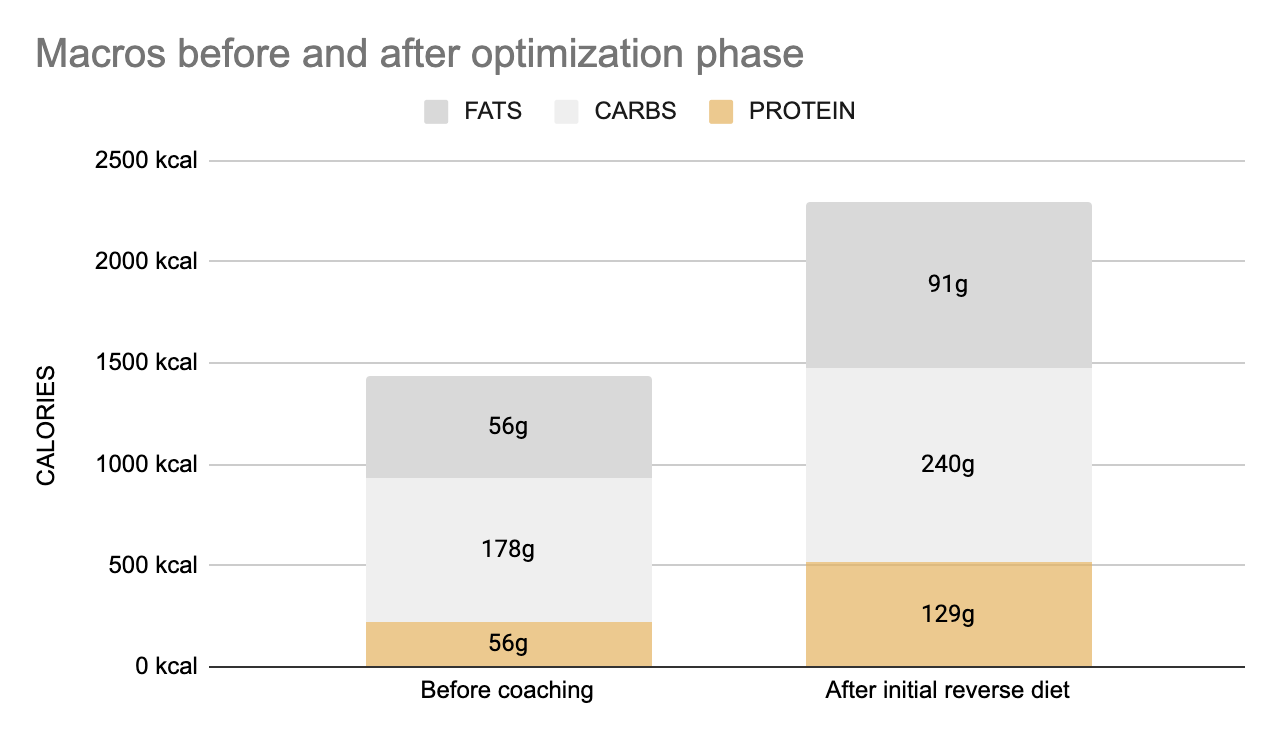
“In the beginning I really had to get used to eating more. It was honestly quite difficult sometimes, especially to get my proteins in, I felt really full. All of the sudden I needed to eat bigger portions, and more often. After a while though, it really wasn’t too bad anymore. My appetite came back, and towards the end of the first phase it just felt like a ‘normal’ amount of food to me. Also! my cravings completely disappeared after increasing my protein intake.”
Over the course of Femke’s optimization phase, she:
- went from 1400 kcal, all the way up to 2200kcal +
- more than doubled her protein intake
- ate more carbs & fats
- ate plenty of fruits and vegetables
- got her daily steps up to 8000-9000
- slept 7-8 hours a night
- drank lots of water
- started exercising again (no crazy amounts of cardio though)
- didn’t cut out any foods
- and more…
Phase 2: Transformation
After addressing the basics and actually eating enough for a while – something she hadn’t done in a really long time – Femke had more energy, no cravings, got more active again, and was finally ready for her next phase. It was time to leverage the hard work she put in during phase 1, it was time for her transformation phase.
After the initial drop down to about 1700-1800kcal, it was all about getting away with as much food as possible, for as long as possible. In case you’re wondering about the specific changes we made: We dropped her fat intake down to 50g, her minimum amount to support hormone production. We also raised her protein intake to 140g, to maintain lean tissue and keep her satiated throughout the process. We then kept in as much carbohydrate as possible.
Throughout the remainder of this phase, we kept protein nice and high and didn’t lower her fat intake even more. This is why further reductions were made by lowering carbohydrate, which kinda sucks because eating carbs has so many benefits.
Femke’s weight didn’t drop right away.. The body doesn’t necessarily appreciate a calorie deficit, as it’s a major form of stress. Your body and metabolism don’t know about the fridge in the next room, or the supermarket around the corner. Your body perceives a calorie deficit as a ‘lack of food’, and often holds on to more water due to the higher stress levels. This can give people the idea that they’re not making progress, and can lead to giving up. Femke however, trusted the process and stuck to her calories. Then after about a week and a half, she experienced ‘the whoosh effect’, a term used to describe the release of fluids by the body. Her weight started to drop, and it would continue to do so for the next few months.
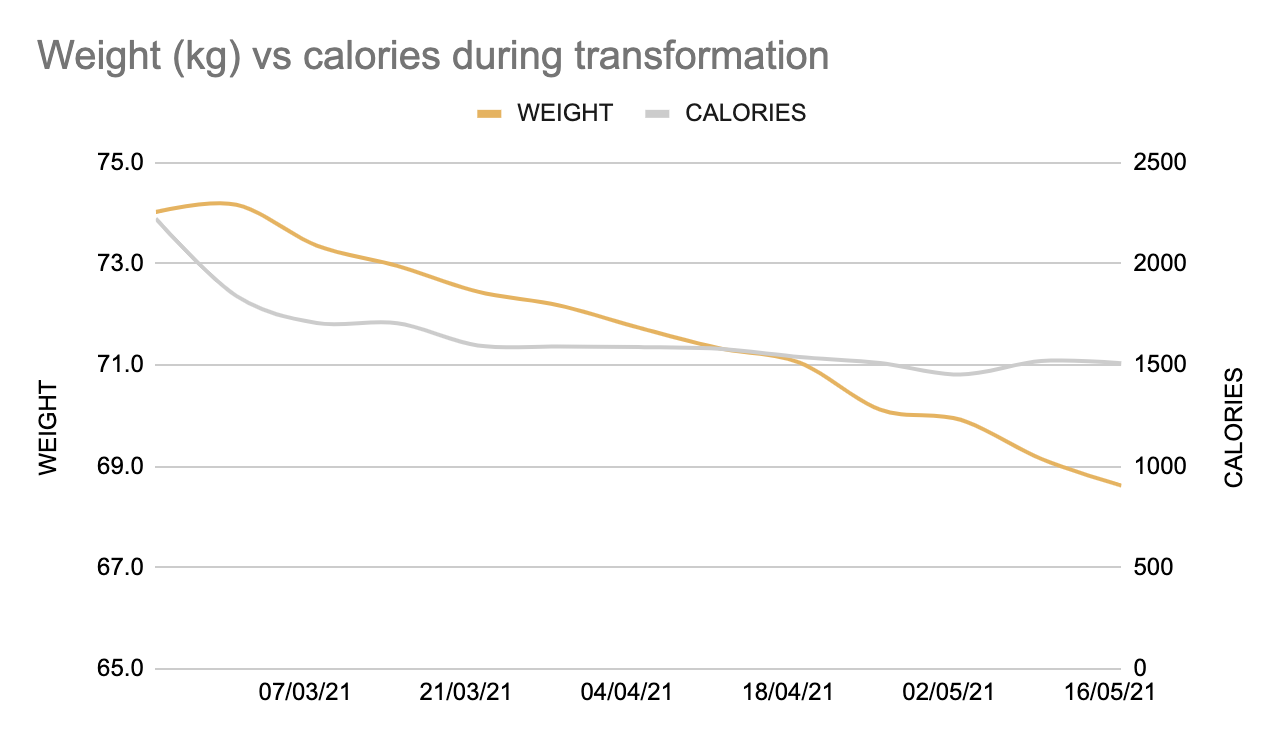
After the initial few weeks at 1700-1800kcal, she spent about 6 weeks around 1500-1600kcal, and only once touched the 1450kcal mark during the very last week of her transformation phase. Crazy to think that back in January, she couldn’t even lose weight at 1400kcal, don’t you think?
“Surprisingly, apart from the very last few weeks, I didn’t feel hungry at all. I ate lots of good foods, and plenty of protein. I actually felt really good during this phase, I noticed I was getting fitter.”
“When should you end a diet?”
I often get the question of how long to continue phase 2. Now, this really depends on the person, how they feel, their goals and actual progress. What we often look for are signs of hunger, low energy, hangry-ness, having trouble sleeping, and more.
In Femke’s case, it was pretty clear. Towards the end of her transformation phase, she noticed that she felt less motivated, had less energy and that she started to get more hungry, more often again. Not to mention, she was happy with her results. We hopped on the phone to discuss our further steps, and agreed on starting phase 3.
Phase 3: Restoration
What happens after the actual transformation will make or break your progress. Phase 3 is essential for long term results. If you want to avoid regaining all the weight you lost, this phase needs to become a non-negotiable part of your fitness journey.
You see, this is exactly where a lot of people go wrong. They think “I’m done with this X-week diet, time to go back to normal”. I always wonder what ‘going back to normal’ means. Does it mean you stop giving a shit about your health and fitness? Does it mean that everything you’ve implemented so far – including food choices, exercise, protein, fiber, etc. – completely goes out the door? Sometimes we need to be brutally honest with ourselves, and realize that whatever we were doing in the past is what led to that initial weight gain in the first place. Which isn’t a bad thing either, just see it as valuable information. Because at least you know what does not work.
There’s no going back to normal.
You’re creating a new normal.
You’re reprogramming your habits.
You’re raising the bar.
After being in a calorie deficit for a while, your metabolism isn’t what it used to be. It has slowed down, meaning you now burn fewer calories. You also require fewer calories, simply because you have lost weight. Not just that, your body also increases your hunger hormones. Your hunger even exceeds your actual energy requirements, making it very possible you’ll give in and overcompensate by eating everything in sight. If weight regain happens too fast, you also risk increasing the amount of fat cells. All of this happens because your body wants to bring you back to homeostasis, and store additional body fat so that next time food is ‘scarce’ you’ll have more energy stored to make it through that period. Remember, that’s how the body perceives a calorie deficit.
But don’t worry, you’re not doomed. Just how your metabolism eventually down regulates when you’re in a calorie deficit, the opposite will happen when you slowly reintroduce food. Our 3rd phase is exactly what you need to finally keep the weight off.
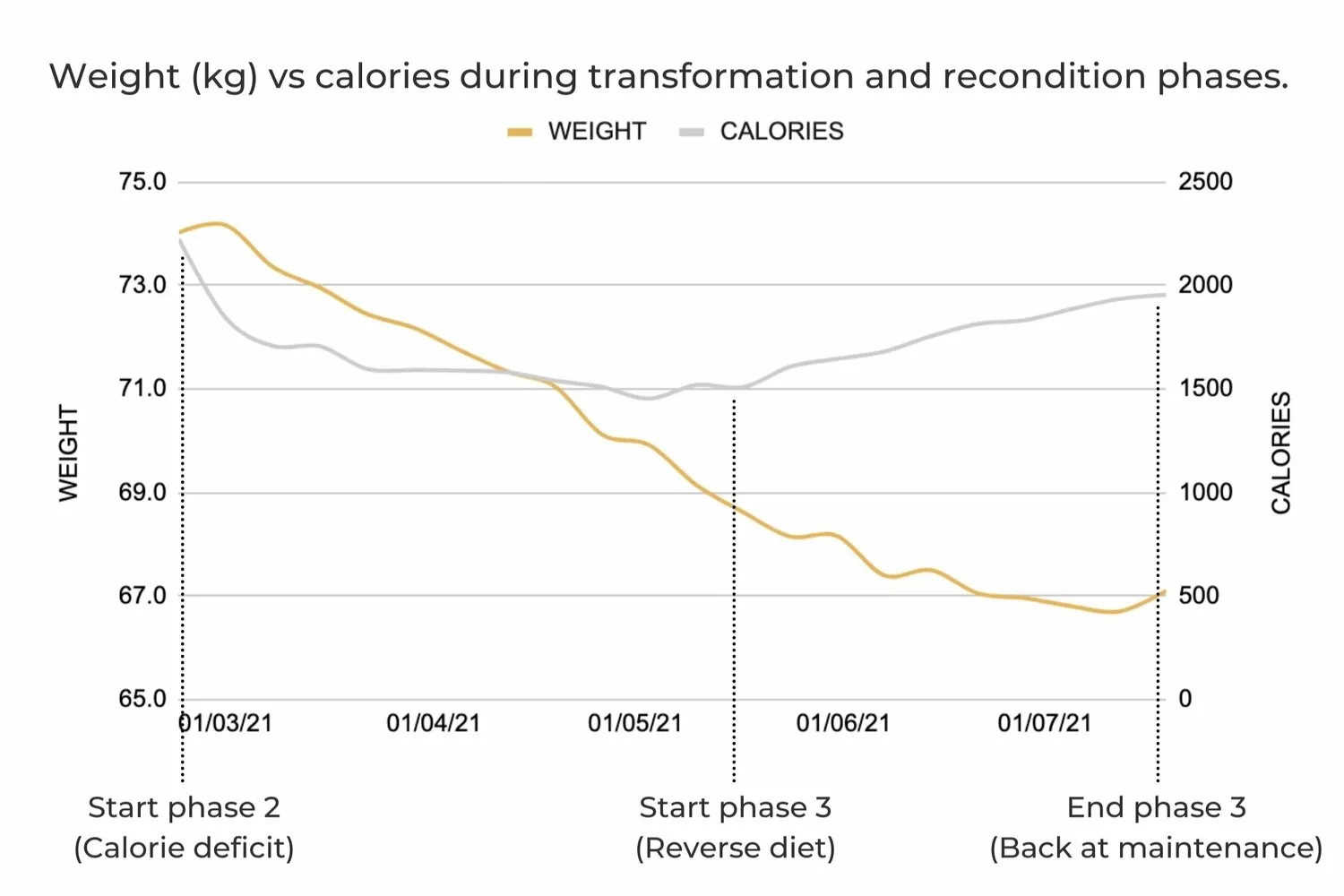
Over the course of just about 2 months, Femke increased her calories a little more every week, this is called a reverse diet. You might be surprised to see that she kept losing weight until the very last week. How does this work? Does this mean that energy balance is complete BS? No, Femke turned out to be what’s called a ‘hyper responder’. When you’re a hyper responder, your energy output may actually overcompensate after upping your food intake, keeping you in a deficit.
During phase 3, we’re reconditioning your metabolism so that you can eat in your maintenance calorie range and most importantly, keep the lost weight off. The goal is to avoid weight regain, not to lose even more weight. Although it is possible, please do not expect to lose more weight during a reverse diet. You see, Femke was simply one of the lucky ones
There are three different scenarios that may happen during a reverse diet:
- You keep losing weight all the way until you’ve reached maintenance.
- You stop losing weight.
- You initially gain some weight.
Wondering what’ll happen when you go through a reverse diet? There’s only one way to find out, and that is to do a reverse diet. And when you do, go into it with the same dedication and patience you would during the actual weight loss phase. When you successfully recondition your metabolism to eat at maintenance – which is often more than expected- you won’t even have to worry about weight regain (given that you keep applying the things you have learned along the way long after you’ve reached your goal).
At what point you’ll reach your actual maintenance calorie range will depend on many factors. But when you take your time, and if you don’t take your calorie deficit to the extremes, all that matters is that you’ll eventually get there.
Phase 4: transition
Femke had reached her goal, and her results reflected her input. She had shown up, consistently, and put in the work necessary to rewire her nutrition and lifestyle habits.
Going through the previous phases, she had proactively learned how to achieve her goals. Things like tracking her food – something she had never done before joining the program – had taught her about food portions, nutrients and more. She now knew how to navigate different scenarios, like busy workdays, eating out or going away for the weekend.
It was time to transition to lifestyle maintenance. Step by step, Femke moved away from tracking macros, the perfect test to see how much you’ve learned. That’s the whole idea behind tracking, you do it to ultimately do better without tracking.
Old pants that used to fit too tight were now too baggy to wear without a belt. Even the belt itself needed replacing. She could now eat as much as her boyfriend, while her weight remained stable. It felt surprisingly easy to keep the weight off. And those damn cravings? They’re a thing of the past.
She really did manage to lose weight by eating more!
I asked Femke what she wanted you, the reader, to take away from this article. Here’s what she had to say.
Don’t go for those super low calorie crash diets. They might get you short term results, but don’t work in the long term. You simply won’t last, and the weight will just come back on in no-time. It’s possible to do it without the restriction, without the crazy amounts of cardio and the constant hunger or sugar cravings. You need to take your time, because it’s not some temporary thing you do for a month or two. Changing your lifestyle, your identity, takes time (in her case, about half a year).
6 months was all it took for her to lay the foundation for long term results. Femke now has the knowledge and tools she needs to maintain and build on her results for life.


